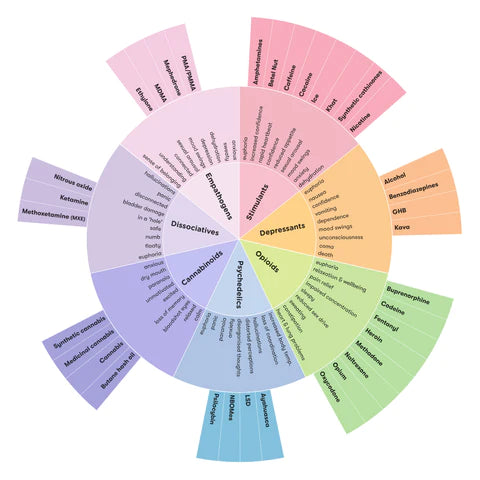The four most commonly used illicit drugs in Australia are marijuana, cocaine, meth/amphetamines and ecstasy. Drug testing kits used for workplace drug testing should cover all these at a minimum.
Drugs can affect different people in different ways. How a drug affects a person can depend on their weight, size, and health, their frequency in using their drug and also the presence of any other drugs in their system. The effects are also dependent on the amount of drugs taken.
With illegal drugs, it can be hard to judge how much has been taken because they are uncontrolled, and therefore the quality and strength of the drug varies from batch to batch.
The effects of drugs, and the symptoms of coming down and withdrawal, can affect a person‘s ability to work safely and effectively, which is why most organisations have a strict zero tolerance towards drugs (and alcohol) in the workplace.
This Drug Wheel classifies drugs as part of seven general categories: stimulants, depressants, cannabinoids, psychedelics, opioids, sissociatives and empathogens.

Different types of drugs have different effects including:
Depressants
Examples: alcohol, benzodiazepines (minor tranquillisers), cannabis, GHB, heroin, morphine, codeine, methadone, and some inhalants.
Effects: They affect the central nervous system by slowing down the messages between the brain and the body. They affect concentration and coordination and can slow down the person‘s ability to respond to unexpected situations.
Dangers: In small doses they can cause the user to feel more relaxed and less inhibited but in larger doses they can cause drowsiness, vomiting, unconsciousness and death.
Stimulants
Examples: caffeine, ephedrine, nicotine, amphetamines, cocaine, ice and ecstasy (MDMA).
Effects: These speed up the messages between the brain and the body, and make the user feel more awake, alert, confident or energetic.
Dangers: Large doses or long-term use of strong stimulants can cause over-stimulation, anxiety, panic, seizures, headaches, stomach cramps, aggression and paranoia.
Dissociatives
Examples: ketamine, LSD, MXE, datura, magic mushrooms (psilocybin) and mescaline (peyote cactus), nitrous oxide. Cannabis and ecstasy can also have hallucinogenic qualities. Effects: These distort a person‘s perception of reality. Users may imagine seeing or hearing things, or distortions of reality through hallucinations.
Dangers: Bladder damage, numbness, weakness, tremors, paranoia and panic attacks, increased heart rate and high blood pressure.
Andatech drug test kits are able to detect a wide variety of different drugs to help workplaces, institutions and even families create a safe environment free from drugs.
If you or a loved one is suffering from a drug addiction, seek help from a medical professional or contact your local Alcohol and Drug Information Service at 1300 13 13 40 for free and private services that provides information, advice, and referrals to alcohol and drug treatment services across Australia.





